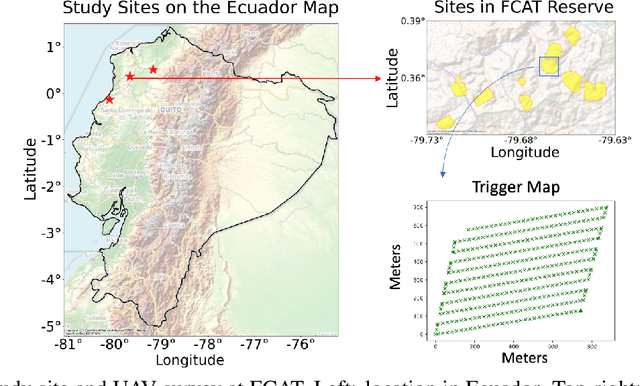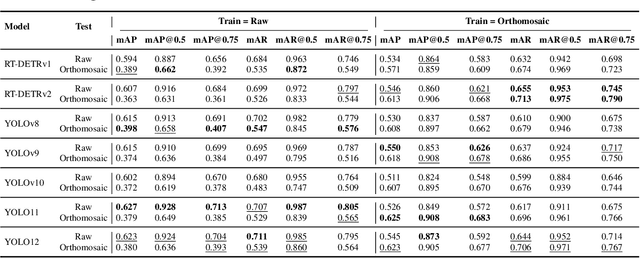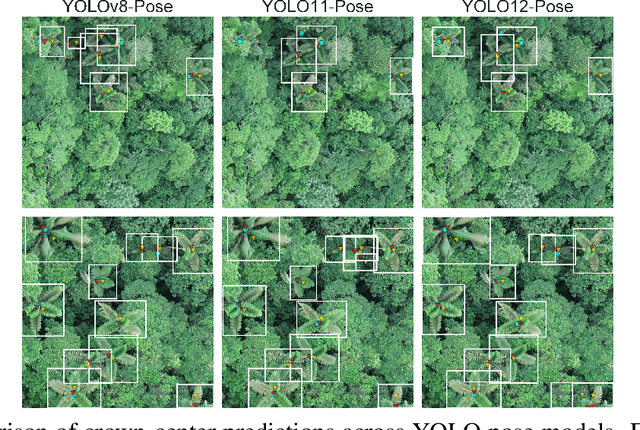Rui-Feng Wang
Cott-ADNet: Lightweight Real-Time Cotton Boll and Flower Detection Under Field Conditions
Sep 15, 2025Abstract:Cotton is one of the most important natural fiber crops worldwide, yet harvesting remains limited by labor-intensive manual picking, low efficiency, and yield losses from missing the optimal harvest window. Accurate recognition of cotton bolls and their maturity is therefore essential for automation, yield estimation, and breeding research. We propose Cott-ADNet, a lightweight real-time detector tailored to cotton boll and flower recognition under complex field conditions. Building on YOLOv11n, Cott-ADNet enhances spatial representation and robustness through improved convolutional designs, while introducing two new modules: a NeLU-enhanced Global Attention Mechanism to better capture weak and low-contrast features, and a Dilated Receptive Field SPPF to expand receptive fields for more effective multi-scale context modeling at low computational cost. We curate a labeled dataset of 4,966 images, and release an external validation set of 1,216 field images to support future research. Experiments show that Cott-ADNet achieves 91.5% Precision, 89.8% Recall, 93.3% mAP50, 71.3% mAP, and 90.6% F1-Score with only 7.5 GFLOPs, maintaining stable performance under multi-scale and rotational variations. These results demonstrate Cott-ADNet as an accurate and efficient solution for in-field deployment, and thus provide a reliable basis for automated cotton harvesting and high-throughput phenotypic analysis. Code and dataset is available at https://github.com/SweefongWong/Cott-ADNet.
From Orthomosaics to Raw UAV Imagery: Enhancing Palm Detection and Crown-Center Localization
Sep 15, 2025



Abstract:Accurate mapping of individual trees is essential for ecological monitoring and forest management. Orthomosaic imagery from unmanned aerial vehicles (UAVs) is widely used, but stitching artifacts and heavy preprocessing limit its suitability for field deployment. This study explores the use of raw UAV imagery for palm detection and crown-center localization in tropical forests. Two research questions are addressed: (1) how detection performance varies across orthomosaic and raw imagery, including within-domain and cross-domain transfer, and (2) to what extent crown-center annotations improve localization accuracy beyond bounding-box centroids. Using state-of-the-art detectors and keypoint models, we show that raw imagery yields superior performance in deployment-relevant scenarios, while orthomosaics retain value for robust cross-domain generalization. Incorporating crown-center annotations in training further improves localization and provides precise tree positions for downstream ecological analyses. These findings offer practical guidance for UAV-based biodiversity and conservation monitoring.
A Local Perspective-based Model for Overlapping Community Detection
Mar 27, 2025Abstract:Community detection, which identifies densely connected node clusters with sparse between-group links, is vital for analyzing network structure and function in real-world systems. Most existing community detection methods based on GCNs primarily focus on node-level information while overlooking community-level features, leading to performance limitations on large-scale networks. To address this issue, we propose LQ-GCN, an overlapping community detection model from a local community perspective. LQ-GCN employs a Bernoulli-Poisson model to construct a community affiliation matrix and form an end-to-end detection framework. By adopting local modularity as the objective function, the model incorporates local community information to enhance the quality and accuracy of clustering results. Additionally, the conventional GCNs architecture is optimized to improve the model capability in identifying overlapping communities in large-scale networks. Experimental results demonstrate that LQ-GCN achieves up to a 33% improvement in Normalized Mutual Information (NMI) and a 26.3% improvement in Recall compared to baseline models across multiple real-world benchmark datasets.
 Add to Chrome
Add to Chrome Add to Firefox
Add to Firefox Add to Edge
Add to Edge